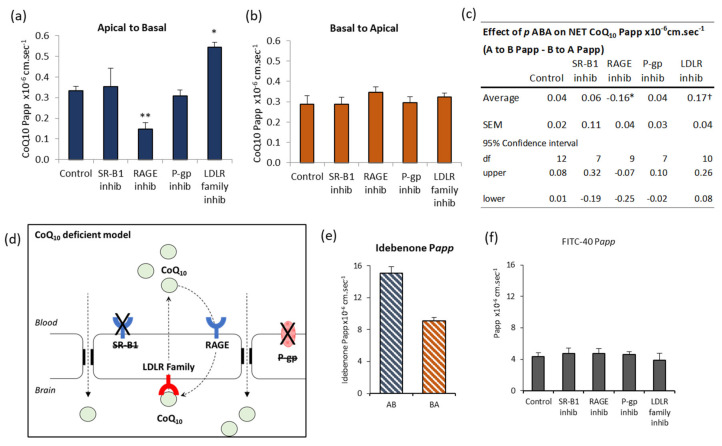Figure 5.
pABA treated bEnd.3 cells: Effect of transport inhibitors on CoQ10 transport. CoQ10 (pre-incubated in serum) transport across pABA treated (1 mM; 5 days) bEnd.3 cells on Transwell filters assayed over 60 min. Inhibitors added apically and basally two hours before assay were BLT-1 (10 µM) for SR-B1, FPS-ZM1 (1 µM) for RAGE, RAP (0.5 µM) for LRP-1/LDLR and verapamil (0.1 mM) for p-glycoprotein. Apparent permeability, Papp, shown for (a) Apical to Basal CoQ10 transport, (b) Basal to Apical CoQ10 transport. (c) The “net” transport of CoQ10 across bEnd.3 cells, calculated from the difference between A to B transport (blood to brain) and B to A transport (brain to blood). “Net” transport in pABA treated control cells was Apical to Basal, toward the brain side. * Treatment with RAGE inhibitor, FPS-ZM1 (1 µM), abolished “net” A to B transport. † Treatment with LRP-1/LDLR inhibitor RAP (0.5 µM), enhanced “net” +ve transport toward the brain side (A to B). The SR-B1 and p-glycoprotein inhibitors BLT-1 (10 µM) and Verapamil (0.1 mM), had no significant effect on “net” transport. (d) Schematic summary of CoQ10 transport across a CoQ10 deficient BBB. “Net” transport shifts toward to the brain side. Uptake via RAGE but SR-B1 is absent. Leaky tight junctions facilitate extra transfer across the BBB. Efflux via LRP-1 is retained. (e) Transport of the CoQ10 analogue, idebenone. Apical to Basal transport exceeded Basal to Apical, meaning there was “net” transport toward the brain. n = 6; values are mean ± SEM * p < 0.05. (f) FITC-40 Apical to Basal transport; n = 4–7; values are mean ± SEM; * p < 0.05, ** p < 0.01; ANOVA single factor; post-hoc Bonferroni.

